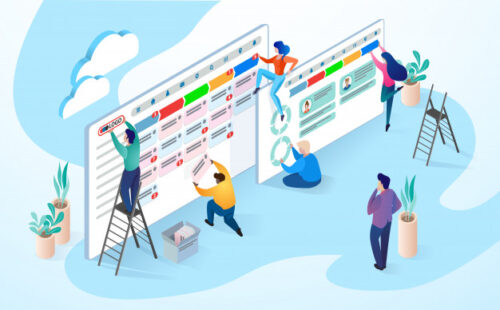So, it’s no secret, that the world is becoming more and more digitalized. Businesses and enterprises all over the world feel tremendous pressure and a quite desperate need to hop on this fast-moving trend of going digital right here right now. But what is actually meant by digital transformation often remains unclear to those trying to implement said changes. Is it a trendy way to introduce new software or is it something worth the thought and effort?
Fundamentally, digital transformation is a continuous process of integration of digital technology into your business, while also changing the operational processes and ways of delivering your core values to customers. Besides that, digital transformation often provokes cultural change, because it requires enterprises to challenge familiar processes, get ready for risks and failures, and question business models that go way back.
Sounds tricky, doesn’t it? So why does everyone keep going further and further with it? Let’s try to find out together.
Impact of the COVID-19
The biggest «why» here is quite easy. We are extremely attached to our technological world, which develops faster every year from AIs and neuro nets to multiple sophisticated software options flooding the market. And with the beginning of the COVID era, those processes went even faster, bringing huge damage to enterprises that were not ready for such a drastic change on such short notice.
Imagine being the owner of a small restaurant, that doesn’t use any of the online delivery services. How can you survive a lockdown or two without your customers being able to order from you? Or how can you continue operating these days without using remote desktop software or cloud technologies, etc? COVID here if not changed the game, then most certainly fast-forwarded it a lot. With people staying at home and being in touch with the world online solely, it became vitally important for any business to go digital as well to at least exist at the same place with their customers.
So, the first «why» here is really simple. You can’t stay the same in a world that changes constantly. If you want to continue reaching your clients and customers and meeting their needs, you need to adapt to the reality they live in.
Maximizing your business potential
The second big «why» is the possibility to use your IT team, software options or technology, that you create, to the fullest. Going through digital transformation doesn’t mean becoming paperless. It means rethinking your ways of using the tech, operating, and communicating with customers in a most effective and productive way. Can you imagine, that what started as a place for people to post pictures of their lunch is now one of the biggest sources of content in the world with a smart feed, that uses neuro nets to sort the content you get according to your affinities?
That is a great example of how you can actually start with a small piece of tech, but gradually develop its complexity and value by adding to its potential.
Increasing your revenue and customer flow
And here we come to the third «why»: going through with digital transformation you get a great chance to actually increase your revenue and customer flow. Adding to your customer’s journey, finding new ways to communicate with them, and integrating tech decisions to operate more effectively rockets your positions on the market and gives you access to new audiences, that you couldn’t reach by operating the old way.
3 steps to digital transformation
Well, the biggest problem here actually is that defining digital can still be tricky. One CEO shared, that saying «digital» is like ordering a salad in the restaurant and getting anything from a cheeseburger to ramen, never being able to predict, what you’re going to get. So, the first step of moving towards digital transformation is simply reviewing your business culture, processes, ways of delivering your messages to the customer, looking for the places you can change, strengthen and modify. Digital transformation can be about improving customer experience, reducing friction, increasing productivity, or elevating profitability, for example.
So, let’s say, you want to work on the customer’s journey. What you need to do is scale-up creating innovative digital experiences: use omnichannel to add depth to your customer’s experience, dive into the atomic content design to create a fool-proof content structure, think about using front-end frameworks to form a more app-like look and feel for your website, and etc.
The second step will be assessing your technical needs and abilities. Don’t forget there are tons of code-free platforms for you to use, so you could craft the customer journey without having to depend on technical teams. You could use squarespace.com and Canva for content and website design, WordPress.com and wix.com can easily provide hosting for reasonable prices, hotjar.com and Google Analytics give you quality analytics visualization for multiple content creation decisions. And these are only a few of the options out there, that give you free and cheap solutions, because sometimes it just doesn’t need to be expensive and complex.
But if you get to an understanding, that to really meet your clients’ demands, you would rather use a custom solution fitting your business needs perfectly, do not hesitate to look for a software development vendor.
So, step three: enable remote workforces and automation. These days employees don’t need to work at a specific place all the time or physically gather in the same room to discuss questions and make decisions. Well, the question is: do you really need to concentrate on domestic hire just to bring everybody together at the office? Which processes can you automate or outsource? While existing in our global work-from-home reality employers had to adapt to remote working. And now the researches tell us, that companies with remote working options actually attract candidates more effectively, than those, who don’t have such options at all.
Also, it gives you access to the worldwide pool of talents, which not only expands your options but rather often provides you with cheaper ones without a lack of performance quality. And considering the reality that we live in it becomes clearer and clearer how beneficial it can be to outsource some of the processes. Without having to hire a bunch of really expensive specialists and managers you actually get entry to teams with really deep and unique expertise, which can be much more efficient and valuable when it comes to meeting your business needs and going through digital transformation.
So, as we can see in the world that changes so fast and so dramatically, it is undeniably hard to survive without fitting its change. You can try and stay afloat fighting hard for your right to do things the old way, but will you be a solid competition? The answer is most certainly no. Because change here is not about blindly following the trends, but it’s first and foremost about meeting your customer’s needs, finding ways to communicate with them effectively, delivering your core values, and operating under the goal of readjusting your cultural habits to those that fit into the existing reality.



































